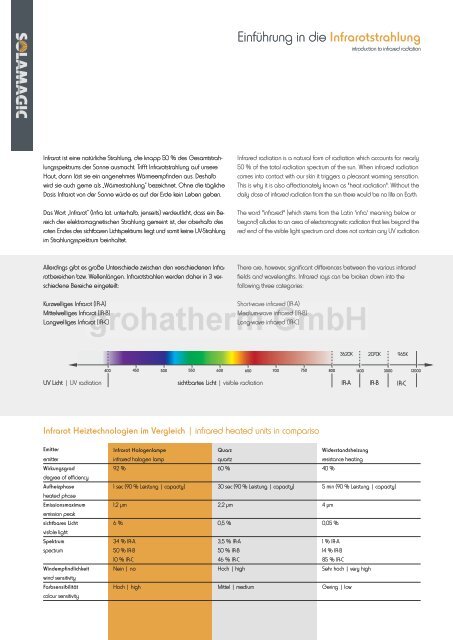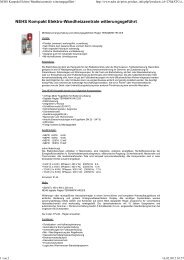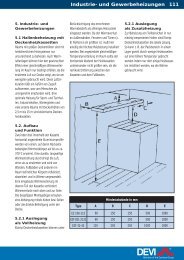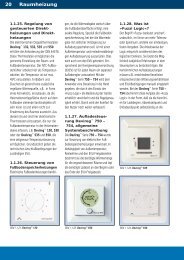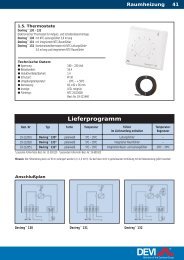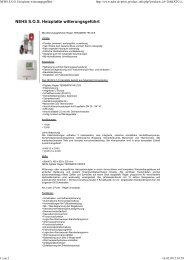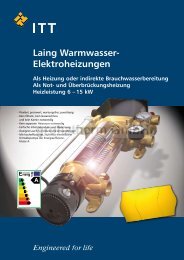Der Umwelt zuliebe - Grohatherm
Der Umwelt zuliebe - Grohatherm
Der Umwelt zuliebe - Grohatherm
Erfolgreiche ePaper selbst erstellen
Machen Sie aus Ihren PDF Publikationen ein blätterbares Flipbook mit unserer einzigartigen Google optimierten e-Paper Software.
Infrarot ist eine natürliche Strahlung, die knapp 50 % des Gesamtstrahlungsspektrums<br />
der Sonne ausmacht. Trifft Infrarotstrahlung auf unsere<br />
Haut, dann löst sie ein angenehmes Wärmeempfinden aus. Deshalb<br />
wird sie auch gerne als „Wärmestrahlung“ bezeichnet. Ohne die tägliche<br />
Dosis Infrarot von der Sonne würde es auf der Erde kein Leben geben.<br />
Das Wort „Infrarot“ (Infra lat. unterhalb, jenseits) verdeutlicht, dass ein Bereich<br />
der elektromagnetischen Strahlung gemeint ist, der oberhalb des<br />
roten Endes des sichtbaren Lichtspektrums liegt und somit keine UV-Strahlung<br />
im Strahlungsspektrum beinhaltet.<br />
Allerdings gibt es große Unterschiede zwischen den verschiedenen Infrarotbereichen<br />
bzw. Wellenlängen. Infrarotstrahlen werden daher in 3 verschiedene<br />
Bereiche eingeteilt:<br />
Kurzwelliges Infrarot (IR-A)<br />
Mittelwelliges Infrarot (IR-B)<br />
Langwelliges Infrarot (IR-C)<br />
Emitter<br />
emitter<br />
Wirkungsgrad<br />
degree of efficiency<br />
Aufheizphase<br />
heated phase<br />
Emissionsmaximum<br />
emission peak<br />
sichtbares Licht<br />
visible light<br />
Spektrum<br />
spectrum<br />
Windempfindlichkeit<br />
wind sensitivity<br />
Farbsensibilität<br />
colour sensitivity<br />
Infrarot Halogenlampe<br />
infrared halogen lamp<br />
92 %<br />
1 sec (90 % Leistung | capacity)<br />
1,2 µm<br />
6 %<br />
34 % IR-A<br />
50 % IR-B<br />
10 % IR-C<br />
Nein | no<br />
Hoch | high<br />
Quarz<br />
quartz<br />
60 %<br />
30 sec (90 % Leistung | capacity)<br />
2,2 µm<br />
0,5 %<br />
3,5 % IR-A<br />
50 % IR-B<br />
46 % IR-C<br />
Hoch | high<br />
Mittel | medium<br />
Einführung in die Infrarotstrahlung<br />
introduction to infrared radiation<br />
Infrared radiation is a natural form of radiation which accounts for nearly<br />
50 % of the total radiation spectrum of the sun. When infrared radiation<br />
comes into contact with our skin it triggers a pleasant warming sensation.<br />
This is why it is also affectionately known as "heat radiation". Without the<br />
daily dose of infrared radiation from the sun there would be no life on Earth.<br />
The word "infrared" (which stems from the Latin 'infra' meaning below or<br />
beyond) alludes to an area of electromagnetic radiation that lies beyond the<br />
red end of the visible light spectrum and does not contain any UV radiation.<br />
There are, however, significant differences between the various infrared<br />
fields and wavelengths. Infrared rays can be broken down into the<br />
following three categories:<br />
Short-wave infrared (IR-A)<br />
Medium-wave infrared (IR-B)<br />
Long-wave infrared (IR-C)<br />
UV Licht | UV radiation sichtbartes Licht | visible radiation<br />
IR-A IR-B IR-C<br />
Infrarot Heiztechnologien im Vergleich | infrared heated units in compariso<br />
Widerstandsheizung<br />
resistance heating<br />
40 %<br />
5 min (90 % Leistung | capacity)<br />
4 µm<br />
0,05 %<br />
1 % IR-A<br />
14 % IR-B<br />
85 % IR-C<br />
Sehr hoch | very high<br />
Gering | low<br />
3620K 2070K 965K


